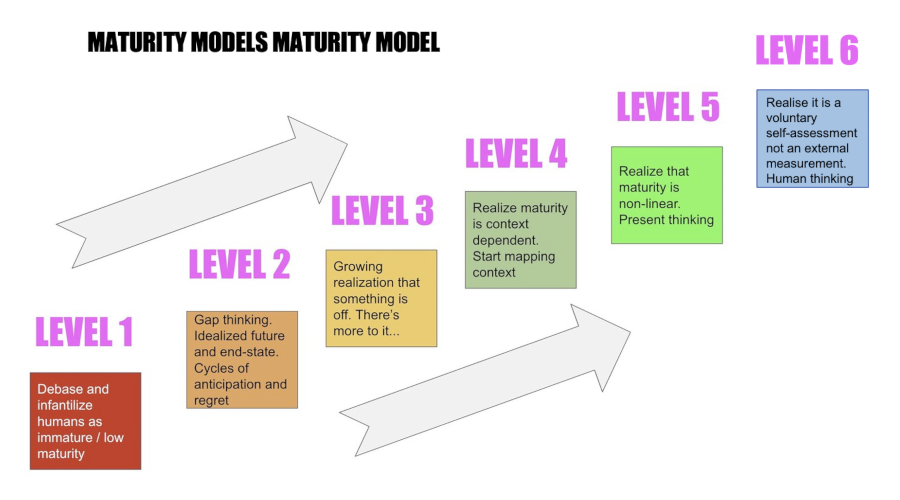
Maturity Models Maturity Model (extended from John Cutler original)
# Agile Maturity Models
Agile Maturity Models are typically forced on people, and in many cases are used to tell teams and team members their understanding and practice of Agile is immature, in a judgmental way that infantilizes them instead of having adult conversations. This does not sit well with the principle of respecting people and self-organising teams, both central in Agile.
Agile Maturity Models also employ gap-thinking between the current state and an idealised future state. And they expect everyone to follow a pre-defined linear progression through given maturity milestones. Doing so Agile Maturity Models imply the existence of a single and rigorous definition of great Agile, which is wrong (see for example Rigorous Agile ![]() by Martin Fowler), and they make wrong assumptions on the learning style of most people.
by Martin Fowler), and they make wrong assumptions on the learning style of most people.
Finally, Agile Maturity Models in their definition of maturity ignore any context, circumstances and specific needs. The irony here is that one of the biggest differences between Agile and pre-Agile approaches is the focus on adapting to the specific context and circumstances and pursuing fitness-for-purpose, and those selling Agile Maturity Models seem to ignore that.
See also
- John Cutler's alternative to linear maturity models ![]() - Barry O'Reilly discussing Why Maturity models don't work
- Barry O'Reilly discussing Why Maturity models don't work ![]() - Chris McDermott suggesting ways to Create context specific maturity models with Wardley Maps
- Chris McDermott suggesting ways to Create context specific maturity models with Wardley Maps ![]() .
.
# Voluntary Agile self-assessments
The alternative to Agile Maturity Models is voluntary Agile Self-assessments where coaching and mentoring are offered, not imposed. They are based on the assumption that Knowledge and understanding can only be volunteered, they cannot be conscripted. So they are based on intrinsic motivation for mastery.
Voluntary Agile self-assessments allow people and teams to volunteer conversations about their Agile adoption creating awareness around opportunities for improvements. They are based on intrinsic motivation and invitation instead of imposition. As such, they shift the goal from measuring people's performance to discussing powerful questions and offering support. The former comes from a place of control and lack of trust, and the latter from a growth mindset.
Voluntary Agile self-assessments focus on the potential for improvements instead of criticizing, they are approached in context-aware ways (the result is not an absolute measure but a relative one), and they recognise that things can move in a non-linear way based on opportunities and personal preferences and learning style. The human element reamins central, and a present-thinking (what we do know from where we stand) replaces a gap-thinking toward an idealised future.
In a voluntary Agile self-assessment, it is the practitioner that: - chooses the self-assessment, and may personalise it like in the Wheel of life coaching tool, to adapt it to its context and circumstances; - decides if, when, and how often to take and review the assessment; - decides to review or not the outcomes with a mentor and to have or not mentoring sessions; - chooses candidate improvement areas; - formulates possible improvement actions; - decides what to do with those actions; - decides or not to collect follow-up feedback and what to do with it; - etc.
In voluntary Agile self-assessments, the understanding and learning of what good looks like is facilitated by mentoring sessions that are made available, by concrete practice whose results can reveal the strengths as well as areas that still need improvement, and the fact that there are multiple iterations of self-assessment and mentoring followed by concrete practice and feedback collection. Also being surrounded by good examples to follow helps a lot too.
# Litmus test
Have those assessed asked for it?
Did they choose the focus area and the timing of the assessment?
Were the assessments personalised for their individual learning journey?
Did they have the freedom, after the assessment, to do what they wanted with the outcome including doing nothing without facing any consequences?
If not, then it is not good enough yet. If yes, way to go 🎉